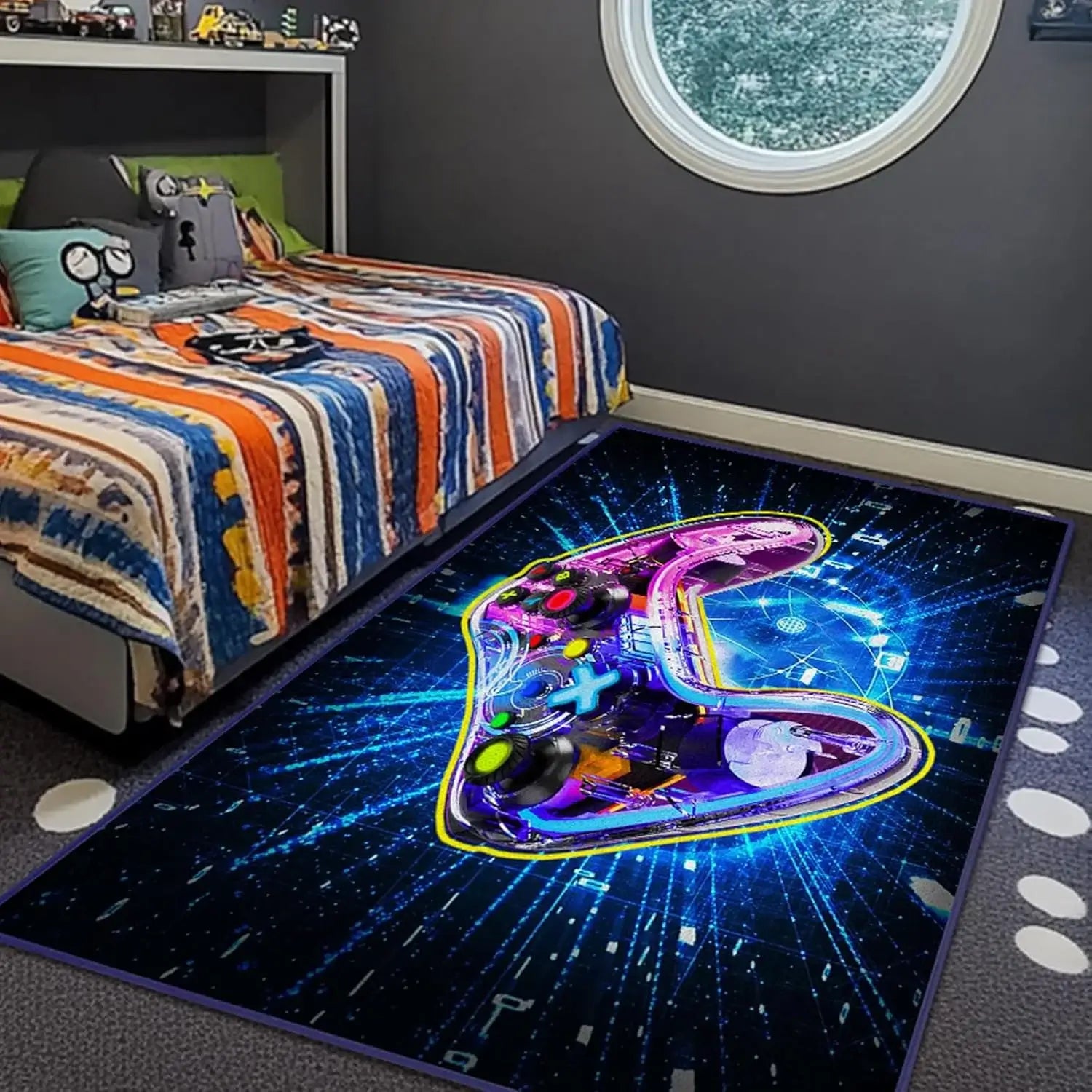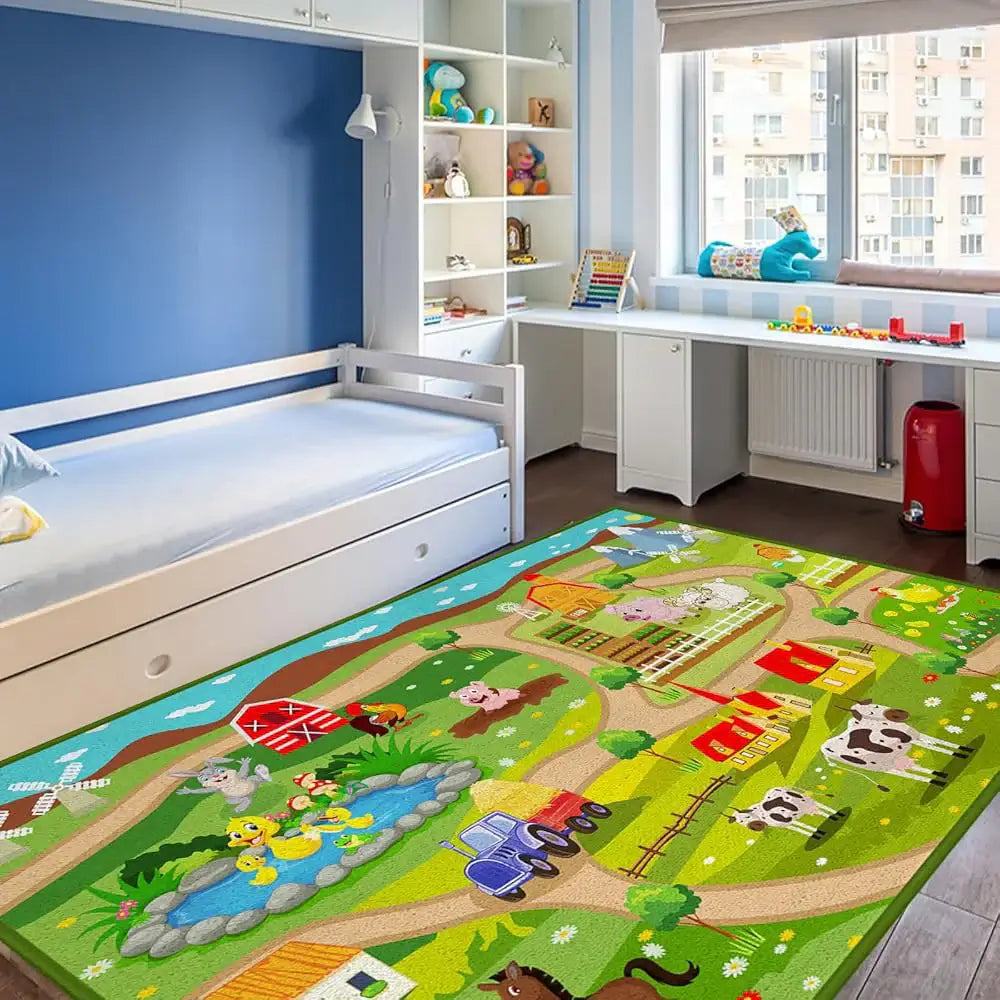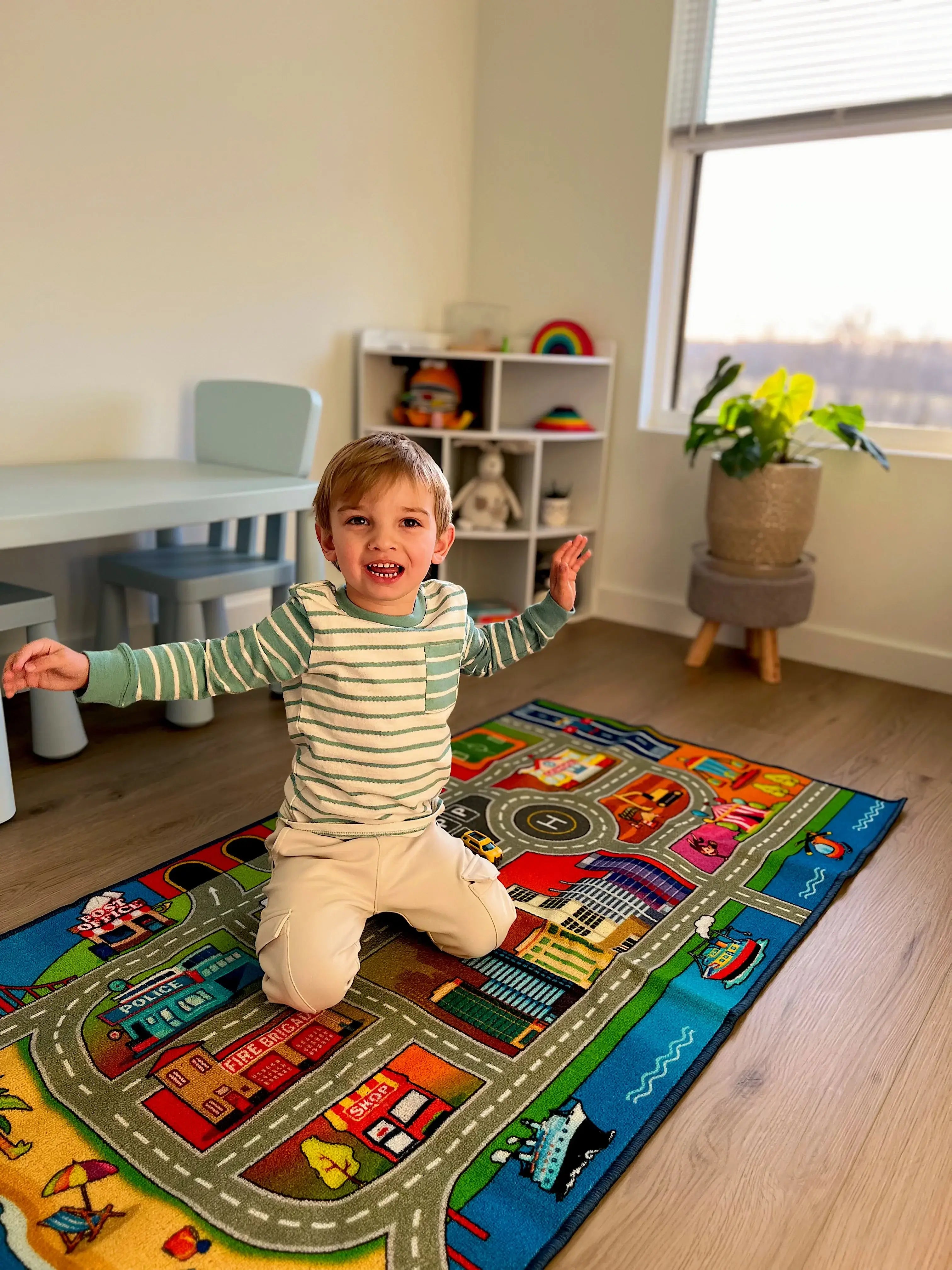The Science Behind Environment-Based Learning
Research consistently demonstrates that physical learning environments significantly impact student achievement, engagement, and retention. According to a comprehensive study published by the University of Salford, well-designed classrooms can improve learning progress by up to 16% in a single academic year. The study emphasizes that environmental factors like color, layout, and thematic elements play crucial roles in cognitive development and academic success.
Subject-based learning environments leverage this research by creating spaces that immediately communicate their purpose and content focus. When students enter a mathematics zone anchored by a number-themed rug, or gather on a world map carpet for geography lessons, their brains begin preparing for subject-specific learning before instruction even begins.
Mathematics Learning Zones: Numbers Come to Life
Mathematics instruction benefits tremendously from visual and kinesthetic learning opportunities that traditional textbook approaches often lack. Number-themed rugs serve as interactive learning surfaces where abstract mathematical concepts become tangible and engaging experiences.
Interactive Number Lines and Hundred Charts
Floor-based number lines allow students to physically move along mathematical sequences, making addition, subtraction, and skip counting active rather than passive experiences. Students can literally step through math problems, using their whole bodies to understand numerical relationships. Similarly, hundred chart rugs enable hands-on exploration of number patterns, multiplication tables, and place value concepts.
Research from Stanford's Jo Boaler emphasizes that mathematical understanding deepens when students engage multiple senses and can visualize abstract concepts. Subject-specific math rugs provide exactly this type of multi-sensory learning foundation.
Geometric Shape Exploration
Rugs featuring geometric patterns and shapes create opportunities for informal geometry learning throughout the day. Students naturally interact with circles, squares, triangles, and more complex polygons as they sit, play, and learn on these surfaces. This constant exposure to geometric concepts builds spatial reasoning skills that support advanced mathematics learning.
For expanded mathematics learning tools, explore our collection of educational math rugs designed to make abstract concepts concrete and engaging.
Language Arts: Creating Literary Landscapes
Reading and writing instruction flourishes in environments that celebrate language and literacy. Subject-themed rugs for language arts create cozy, book-friendly spaces that invite students to dive deep into literary experiences.
Alphabet and Phonics Foundations
For early elementary students, alphabet rugs provide constant visual reinforcement of letter recognition and phonemic awareness. Students can play letter games, practice spelling by jumping to different letters, or simply absorb alphabetic principles through daily exposure to well-designed letter displays.
The International Literacy Association highlights how environmental print—including letters and words displayed throughout learning spaces—supports literacy development by making reading and writing feel natural and accessible.
Story Circles and Reading Communities
Themed rugs that celebrate famous children's literature, storytelling elements, or reading themes create natural gathering spaces for shared reading experiences. These designated areas signal to students that reading is valued and enjoyable, not just academic work to be completed.
Story-themed rugs can feature favorite characters, storybook settings, or reading-related imagery that sparks conversation and connection to literature. When students associate positive feelings with these reading spaces, they're more likely to choose reading during free time and develop lifelong literacy habits.
Discover our complete selection of literacy-focused classroom rugs that transform any space into a literature-loving environment.
Science Exploration: Bringing the Natural World Indoors
Science education thrives on curiosity, observation, and hands-on investigation. Subject-specific science rugs can transform classroom floors into ecosystems, solar systems, or laboratory spaces that spark scientific thinking and inquiry.
Life Science and Ecosystems
Rugs depicting various habitats—forests, oceans, deserts, or rainforests—create immersive environments where students can role-play as different animals, discuss food chains, or explore adaptation concepts. These visual representations help students understand complex ecological relationships and develop environmental awareness.
According to research from the National Science Foundation, early exposure to science concepts through environmental design and hands-on experiences significantly impacts later STEM achievement and interest.
Space and Astronomy Learning
Solar system rugs allow students to physically explore planetary relationships, practice ordering planets by size or distance from the sun, or act out orbital patterns. This kinesthetic approach to astronomy concepts helps students grasp the vast scales and relationships that can be difficult to understand through textbooks alone.
Scientific Method and Laboratory Skills
Rugs designed with scientific equipment, measurement tools, or laboratory safety reminders create spaces where students can practice scientific thinking and procedures. These environmental cues reinforce proper scientific practices and help students develop the systematic thinking skills essential for scientific inquiry.
Social Studies: Exploring Cultures and Geography
Social studies education benefits enormously from visual and spatial learning tools that help students understand geographic relationships, cultural connections, and historical contexts. World maps, cultural themes, and historical timeline rugs create learning environments that make distant places and times feel accessible and relevant.
Geographic Literacy Through Map-Based Learning
World map rugs serve as constant geographic references that students interact with daily. Whether they're sitting on different continents during morning meetings or tracing trade routes during history lessons, these floor maps make geography tangible and memorable.
Research from the National Geographic Society demonstrates that spatial thinking skills developed through map interaction support not only social studies learning but also mathematics, science, and critical thinking across all subjects.
Cultural Awareness and Global Citizenship
Rugs featuring cultural symbols, world flags, or multicultural themes create opportunities for ongoing discussions about diversity, global connections, and cultural appreciation. These environmental elements help students develop cultural competency and global awareness essential for 21st-century citizenship.
Browse our collection of geography and social studies rugs that make the world feel smaller and more connected.
Arts Integration: Creativity Meets Curriculum
Arts-integrated learning environments recognize that creativity enhances understanding across all subject areas. Arts-themed rugs create spaces where students can express themselves, explore artistic concepts, and use creative thinking to deepen academic learning.
Music and Movement Spaces
Rugs featuring musical notes, instruments, or rhythm patterns create natural spaces for music integration throughout the curriculum. Students can use these spaces for brain breaks, transition activities, or cross-curricular lessons that combine music with mathematics, language arts, or social studies content.
The Arts Education Partnership reports that students in schools with strong arts integration programs show improved academic achievement, increased creativity, and better social-emotional development.
Visual Arts and Creative Expression
Art-themed rugs can showcase famous artworks, color wheels, or artistic techniques that inspire creativity and provide reference points for arts instruction. These spaces encourage students to see themselves as artists and creators, not just consumers of information.
Flexible Design for Multi-Subject Integration
The most effective subject-based learning environments maintain flexibility for cross-curricular instruction and integrated learning experiences. Modular rug systems allow educators to reconfigure spaces based on daily lessons, seasonal themes, or special projects.
STEAM Learning Environments
Science, Technology, Engineering, Arts, and Mathematics (STEAM) education requires spaces that support interdisciplinary thinking and project-based learning. Combination rugs that feature elements from multiple subjects—like mathematical patterns in nature or geometric art designs—create environments that naturally promote integrated thinking.
Seasonal and Thematic Flexibility
Consider rotating seasonal rug displays or maintaining neutral base rugs with changeable thematic elements. This approach keeps learning environments fresh and allows for timely connections to current events, seasonal changes, or special curriculum focuses.
Implementation Strategies for Maximum Impact
Zone Definition and Traffic Flow
Effective subject-based environments require clear zone definitions that students can easily understand and navigate. Use different sized rugs to create distinct learning areas while maintaining logical traffic patterns that don't disrupt instruction or create safety hazards.
Student Ownership and Care
Involve students in maintaining and caring for subject-specific learning spaces. When students take ownership of their specialized learning environments, they develop stronger connections to both the physical space and the academic content it represents.
Assessment and Adaptation
Regularly observe how students interact with subject-based rug areas and adjust placements or themes based on actual usage patterns. The most effective learning environments evolve based on student needs and preferences rather than remaining static throughout the year.
For comprehensive classroom design solutions, explore our full range of subject-specific educational rugs that support learning across all curriculum areas.
The Long-Term Impact of Thoughtful Design
Subject-based learning environments created through strategic rug placement and thematic design do more than improve test scores—they help students develop positive associations with learning that last throughout their educational journey. When students experience mathematics as an active, engaging exploration rather than abstract drill work, or when they associate reading with cozy, comfortable spaces rather than rigid assignments, they're more likely to pursue these subjects with enthusiasm and confidence.
Creating these specialized learning zones requires investment in thoughtful design, but the returns—in terms of student engagement, academic achievement, and lifelong learning attitudes—make this investment invaluable for any educational setting committed to student success.
The transformation from traditional classroom to subject-based learning environment begins with understanding that every element in the space either supports or hinders learning. Choose wisely, and watch as students thrive in environments designed specifically for their educational success.




Leave a comment
This site is protected by hCaptcha and the hCaptcha Privacy Policy and Terms of Service apply.